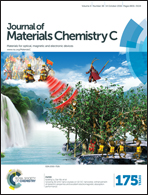Dual-activator luminescence of RE/TM:Y3Al5O12 (RE = Eu3+, Tb3+, Dy3+; TM = Mn4+, Cr3+) phosphors for self-referencing optical thermometry†
Abstract
Traditional optical temperature sensors based on the rare earth fluorescence intensity ratio of two thermally coupled energy states have intrinsic limitations such as low relative sensitivity and large detection error due to the requirement of a narrow energy gap. Herein, a strategy involving the use of rare earth and transition metal dual-emitting centers with completely different thermal-quenching behaviors has been developed to achieve high temperature sensitivity and good discrimination of signals. In particular, Eu3+/Mn4+:Y3Al5O12 with strikingly high absolute and relative sensitivities of 0.441 K−1 and 4.81% K−1 as well as a large energy gap of 2100 cm−1 was realized by taking advantage of Eu3+ luminescence as a reference signal and Mn4+ luminescence as a temperature signal. The versatility of the proposed strategy has been demonstrated by adopting other Tb3+/Mn4+, Dy3+/Mn4+, Eu3+/Cr3+ and Dy3+/Cr3+ dual-activator combinations. It is expected that this preliminary study will provide an important advance in exploring novel self-referencing optical thermometry with excellent performance.


 Please wait while we load your content...
Please wait while we load your content...